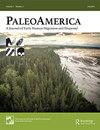The Geochronological and Geoarchaeological Context of the Clovis-Age La Prele Mammoth Site (48CO1401), Converse County, Wyoming
IF 1.7
Q1 ANTHROPOLOGY
引用次数: 0
Abstract
ABSTRACT The La Prele Mammoth site (48CO1401), located in Converse County, Wyoming, contains a Clovis-age occupation associated with the remains of a subadult mammoth (Mammuthus columbi). In this paper, we present the geochronological and geoarchaeological context of the site. The La Prele Mammoth site is buried in an alluvial terrace of La Prele Creek, a tributary of the North Platte River, which acts as an important migration corridor through the Rocky Mountains. Archaeological remains, buried by a series of flood deposits, occur within or below a well-developed buried A horizon, referred to as the Mammoth Soil. Bioturbation of the site has resulted in vertical artifact movement, though peaks in artifact density are evident in vertical artifact distributions and likely represent the occupation surface. Radiocarbon dating of this occupation, including several new dates, suggests an age of 12,941 ± 56 calendar years ago (cal yr BP).怀俄明州Converse县Clovis时代La Prele猛犸象遗址(48CO1401)的地质年代和地质考古背景
本文章由计算机程序翻译,如有差异,请以英文原文为准。
求助全文
约1分钟内获得全文
求助全文
来源期刊

PaleoAmerica
Earth and Planetary Sciences-Paleontology
CiteScore
3.70
自引率
0.00%
发文量
15
期刊介绍:
PaleoAmerica disseminates new research results and ideas about early human dispersal and migrations, with a particular focus on the Americas. It fosters an interdisciplinary dialog between archaeologists, geneticists and other scientists investigating the dispersal of modern humans during the late Pleistocene. The journal has three goals: First and foremost, the journal is a vehicle for the presentation of new research results. Second, it includes editorials on special topics written by leaders in the field. Third, the journal solicits essays covering current debates in the field, the state of research in relevant disciplines, and summaries of new research findings in a particular region, for example Beringia, the Eastern Seaboard or the Southern Cone of South America. Although the journal’s focus is the peopling of the Americas, editorials and research essays also highlight the investigation of early human colonization of empty lands in other areas of the world. As techniques are developing so rapidly, work in other regions can be very relevant to the Americas, so the journal will publish research relating to other regions which has relevance to research on the Americas.
 求助内容:
求助内容: 应助结果提醒方式:
应助结果提醒方式:


